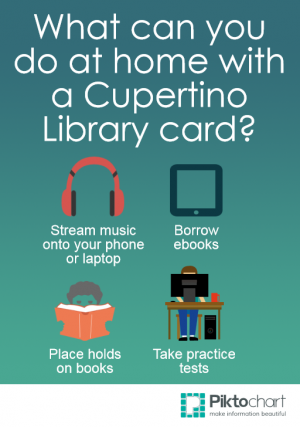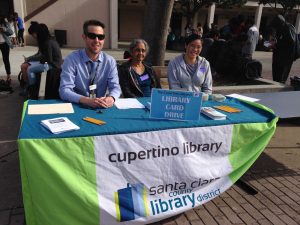
Teen services librarian Matt Lorenzo and his colleagues from the Cupertino Library’s circulation department set up a table at lunch on Jan. 16 in the Academic Court to register students for Santa Clara County Library cards.By the end of lunch, around 50 MVHS students had signed up – granting them access to the district’s online resources as well as the ability to borrow books from any countyt library. El Estoque spoke to Lorenzo about the importance of having a card and the reasoning behind the drive.
El Estoque: What inspired this drive?
Matt Lorenzo: We’re expanding our services to teenagers here in the Cupertino area. We have been expanding our collection of of books, streaming music through the library website [and increasing our] database services, ebooks and college prep test preparation services, so we want to make sure that every single student in the FUHSD school district has a library card and knows how to access our services because … we no longer just set books on a shelf anymore. It’s a lot of outreach services, and it’s all free.
EE: How did you organize the drive?
Lorenzo: I worked very closely with your high school librarian [Laura] Utile. Over the course of two months, we presented to PTSA and we did a joint presentation about t he benefits of students actually doing research, rather than just finding information [from] Google [and] finding information here at MVHS using databases and electronic resources found in the library.
he benefits of students actually doing research, rather than just finding information [from] Google [and] finding information here at MVHS using databases and electronic resources found in the library.
EE: Why should teens get a library card?

Lorenzo: I’m not here just to get kids to to go to the library. You can use our services just by using a library card, even in your own home. You can place holds on books, take practice tests, download ebooks, stream music directly onto your phone or [on your] laptop … at home. Even if you don’t have the time to come into the Cupertino Library, there is great benefit to having access to our services online as well.
EE: How has the library evolved?
Lorenzo: We’re no longer a place that’s just based on research. People [go] there to study, teenagers [go] there to hang out, to check out books, to meet with their friends, to study in groups and to do different things. It’s no longer a place where you have to sit in your desk and be quiet. We want it to be a social place, a safe place for teens and a very welcoming place.







